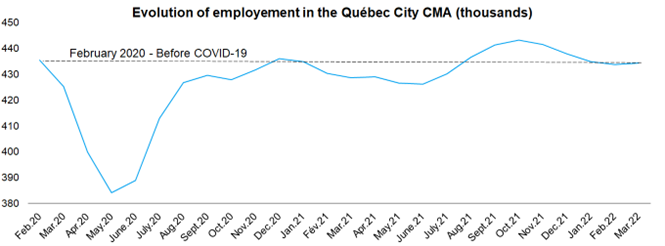Highlights
- The Labour Force Survey (LFS) reported 446,300 people in the labour force in the Québec City census metropolitan area (CMA) in March 2022, almost as many as in February. Compared to March 2021, this is a drop of 4,600 people (-1.0%).
- Data also shows that the labour market varied very slightly this month, with 434,400 jobs, 600 more than in February (+0.1%). Compared to March 2021, Québec City gained 5,800 jobs (+1.4%).
- The unemployment rate dropped slightly to 2.7%, the lowest among major Canadian CMAs. This rate is close to the historical low registered in summer 2019 (2.4%).
- In the province of Quebec, comparable data shows that employment also remained relatively stable (+0.3%), while the unemployment rate settled at 4.7%.
Charts
 Source: Statistics Canada. Table 14-10-0380-01.
Source: Statistics Canada. Table 14-10-0380-01.

Cautionary Note
The available data for the Québec City census metropolitan area (CMA) was given special statistical treatment (three-month moving average) due to the small sample size, which has the effect of mitigating the large fluctuations in the data. Thus, the data collected in January and February influenced the estimations published for March. Please also note that we use comparable data for the province of Quebec and the other CMAs in this document.
Commentary
In the Labour Force Survey (LFS), Statistics Canada published employment data for the month of March (reference week of March 13 to 19, 2022). Some changes took place since the previous release of the LFS: working from home is no longer mandatory (February 28), and neither is the vaccination passport (March 12).
Shrinking Labour Force
The labour force represents the number of people available for work in the economy. It includes those aged 15 and over who are employed, who run a business or who are unemployed and available for work, In March 2022, this group included 446,300 people, 4,600 fewer than in March 2021 (-1.0%). This number is also lower than before the pandemic (454,000). This is explained in part by labour market participation not recovering in the Québec City region after the impact from COVID-19. The participation rate reached 64.6%, the lowest among the larger Canadian CMAs.
Higher Employment
In March 2022, there were 5,800 more jobs in Québec City (+1.4%) than at the same time last year (428,600). Most Canadian CMAs also saw an increase in the number of jobs. However, the Québec City region only ranked 7th in terms of performance over one year among the eight major Canadian CMAs, before Ottawa (+6.0%).
Tightening Labour Market
The unemployment rate dropped slightly from February to March 2022 (0.1 percentage point). However, year over year, it went from 4.9% in March 2021 to 2.7% in March 2022. Québec City has the lowest unemployment rate among the major Canadian regions. Moreover, this rate is close to the historical low registered in summer 2019 (2.4%).
From March 2021 to March 2022, employment growth (+1.4%) was higher than labour force growth (-1.0%) as well as the growth of the population aged 15 and over (+0.6%) in Québec City. All seems to suggest that labour market evolution in the coming months will depend on the number of available workers.
Émile Émond
Economist
Québec International




